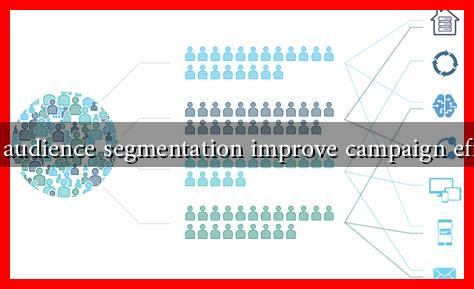-
Table of Contents
How Does Audience Segmentation Improve Campaign Effectiveness?
In the ever-evolving landscape of marketing, understanding your audience is paramount. Audience segmentation is a strategic approach that divides a broad target market into subsets of consumers who have common needs, interests, or characteristics. This article explores how audience segmentation enhances campaign effectiveness, providing insights, examples, and statistics to illustrate its importance.
Understanding Audience Segmentation
Audience segmentation involves categorizing potential customers based on various criteria, including:
- Demographics: Age, gender, income, education level, etc.
- Geographics: Location, climate, urban vs. rural settings.
- Psychographics: Lifestyle, values, interests, and personality traits.
- Behavioral: Purchasing behavior, brand loyalty, and product usage.
By segmenting audiences, marketers can tailor their messages and campaigns to resonate more deeply with specific groups, leading to improved engagement and conversion rates.
The Benefits of Audience Segmentation
Implementing audience segmentation can significantly enhance the effectiveness of marketing campaigns. Here are some key benefits:
- Personalized Messaging: Tailoring messages to specific segments allows brands to speak directly to the needs and desires of their audience. For instance, a luxury car brand may target affluent consumers with messages emphasizing status and exclusivity, while a budget car brand may focus on affordability and reliability.
- Improved ROI: According to a study by the American Marketing Association, targeted marketing campaigns can yield a 20% increase in sales. By focusing resources on specific segments, companies can achieve higher returns on their marketing investments.
- Enhanced Customer Experience: Segmentation allows brands to create more relevant experiences for their customers. For example, Netflix uses viewing history to segment its audience, providing personalized recommendations that enhance user satisfaction and retention.
- Better Resource Allocation: By identifying high-value segments, businesses can allocate their marketing budgets more effectively, ensuring that resources are directed toward the most promising opportunities.
Case Studies: Successful Audience Segmentation
Several companies have successfully leveraged audience segmentation to improve their campaign effectiveness:
- Coca-Cola: The beverage giant uses demographic and psychographic segmentation to create targeted campaigns. For instance, their “Share a Coke” campaign personalized bottles with popular names, appealing to younger consumers and driving significant sales increases.
- Amazon: Amazon employs behavioral segmentation by analyzing customer purchase history and browsing behavior. This data allows them to send personalized recommendations and targeted promotions, resulting in higher conversion rates and customer loyalty.
- Spotify: Spotify uses psychographic segmentation to create personalized playlists and recommendations based on users’ listening habits. This approach not only enhances user experience but also increases user engagement and retention.
Statistics Supporting Audience Segmentation
Several studies highlight the effectiveness of audience segmentation:
- According to a report by MarketingProfs, 72% of consumers only engage with marketing messages that are customized to their interests.
- A study by Forbes found that segmented email campaigns have an open rate of 14.32% compared to 11.4% for non-segmented campaigns.
Conclusion
In conclusion, audience segmentation is a powerful tool that can significantly enhance the effectiveness of marketing campaigns. By understanding the unique characteristics and preferences of different consumer groups, brands can create personalized messages, improve customer experiences, and achieve better returns on their marketing investments. As demonstrated by successful companies like Coca-Cola, Amazon, and Spotify, effective audience segmentation not only drives engagement but also fosters long-term customer loyalty. In a world where consumers are bombarded with messages, segmentation is the key to standing out and making a meaningful connection.

